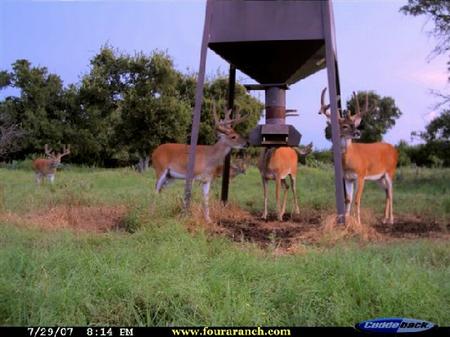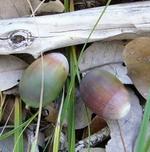
Genetics (genes) are the most important factor in determining antler characteristics in whitetail bucks. However, genes are not the only factors that determines a buck’s antler potential. Both age and nutritioninfluence how a deer’s genes are expressed. For example, even a buck with the genetic composition to grow the largest rack in the world was harvested at a young age or was malnourished, then the genes that the buck carried were never fully observed. Because age and nutrition determine how a buck’s genes are expressed, these factors are critical to the success of a sound deer management program that strives to produce high-quality bucks.
Although proper buck harvest is necessary to promote age and antler characteristics, nutrition can be achieved through a combination of habitat management and supplemental feeding. Habitat management is the single best way to provide year-round, high-quality food for deer, but this is typically only a viable option for land owners. Habitat management is not always feasible for hunters that lease land for deer hunting for a variety of reasons. In this case, hunters are limited to providing supplemental food through either food plots or free-choice protein pellets.
Through the years I have often received emails from concerned hunters asking, “Why are deer not eating my protein pellets?” Usually, this is because it’s the first time protein pellets have been offered in the area. Deer are simply not familiar with them. In this case, I always suggest mixing corn and protein pellets at a rate of 50:50 and then broadcasting some of the mix around the feeder. After deer empty the corn-protein mix, adjust the proportions to 75% pellets and 25% corn. When that runs out, go with 100% pellets in your free-choice feeder.

To sum up, if deer are not eating your protein pellets it’s either because they are not familiar with them or they do not need them. If you place out a new protein feeder during the spring or fall, do not expect deer to hit them very quick. On the flip side, placing a supplemental feed station out during a high-stress period, such as summer or winter, may promote the animals finding and using the feeder much more quickly.
I live in upstate New York and own 300 acres of land in an area known for big bucks and a lot of does. It is illegal to feed deer in NY state so instead of feeding corn and protein and planting clover, I decided to make several small fields and plant mostly soybeans due to nutrient rich and protein characteristics of the plant. I also planted about 25% of my plots with dwarf rape and about 10% buck wheat. My question is was this a smart choice and what can I do better? Appreciate any advice from anyone.
If I know the soil type and PH of the soil the mixture of the legumes can be better determined. The mixture you are planting sounds like a very good mix. Remember though, different plants mature at different times. I find that this a very important factor to consider. You would like your plot to be an ongoing food source for as long as possible.Try and match different plants to produce over a longer time. This way its not a “steak dinner” all at once.
Gordon, soybeans are great in areas that have low whitetail deer populations, otherwise it’s “lights out” after they sprout and the deer nip off the first two leaves. Rape is plant often used in fall or winter food plots, but it may produce at your latitude during the summer because of the cooler temperatures. Whitetail will not consume this plant until it reaches maturity, if it grows for you. Buckwheat can handle a variety of soils, so this plant should work really well for you. Always good to try several species in your food plot, then evaluate what works and what does not.
We have about 100 acres east of Waco, Texas. We fed protein pellets from some homemade gravity feeders until the hogs discovered them, but we had pictures of deer eating out of them too. We then got a 300 pound All Season gravity feeder and put hog fence around it earlier this year, but have not had a single picture of a deer eating from it. With the drought Texas has been in, why wouldn’t the deer be eating the pellets? Our deer here also do not visit our corn feeders very often, we mainly get visited by hogs when we throw corn. Any idea on this matter or suggestions for us?
I have a 55 acre lease in Zephyr, Texas. Lots of doe and big bucks in the area. How would I go about getting them on my place and staying around there? Thanks.
Noah, Buck Manager will have a great suggestion as well, but I can offer some advice.
Firstly, 55 acres would encompass only a fraction of a mature buck’s range (with the possibility of overlap of several bucks). So keep that in mind when trying to keep deer in the area.
Secondly, if you want deer to come to you, you must have something they want (and preferably better than what the neighbor has to offer). Whether it’s protein pellets, food plots, corn, water, or charges of alfalfa hay. If you have a couple of good water sources, that would be a start.
Thirdly, human disturbance can make a a huge difference. How often is the 55 acres being driven through with vehicles, 4-wheelers, etc.? I know people who ride their entire property every day when they get there and after the morning hunts to “see deer.” They even spotlight at night sometimes to, again, “see deer.” They end up spooking all the deer off their tracts and changing the deer’s habits. Your bigger bucks won’t tolerate being spooked too often and they will find another place to feed. You can cover 55 acres in very little time when driving around.
How often are you checking your feeder and stand before deer season? The less human scent in the area, the more likely you will have higher concentrations of deer.
Fourth, deer concentration could present a problem. How many mature bucks do you see? I have an area where a big mature 6 pointer was hanging around. He was the only mature buck we saw in the area for almost a month. The day deer season started we took him out immediately. Within 2 days a couple of mature 10 pointers moved into the area. The big 6 had staked off his territory and apparently drove the other bucks off.
Lastly, hunting pressure can play a big part. How many hunters are on 55 acres and how many hunters neighbor your lease? Once those cannons start going off, those mature bucks may head to cover and only come out to chase does… and some won’t come out for that until nightfall hits.
Best of luck to you.
We have about 100 ac of coastal hay field that buts into brush – we keep 3 feeders running year around with soy/corn mix early we too have an abundance of acorns. What do you suggest to build the big super bucks. Food plot ideas for droughty area? How do we draw them out of the brush into our feeder areas?
Debbie, I recommend improving the habitat found on the property if you are interested in white-tailed deer. Coastal is great for cows, but not so much for deer. Consider converting some of that to better cover and habitat for deer. Also, the abundance of acorns trumps any feed you can offer. Provide good habitat, let them grow and the older bucks should eventually get there.
I have a 55 acre place just west of Waco and was told by the game warden that there is 1 deer per 25 acres in this area. I have a photo of 7 bucks at the feeder at the same time with a few really good horns. I have to attract deer as my place is not large enough to hold them. I have a 4 food plot that is planted 3 acres oats and one acre Austrian winter peas. I provide year round feeding of corn, a salt block, and I provide extra water with an on demand 200 gallon watering station, as there are few places for the deer in the area to get water and we are still in the middle of what I call a drought. I have photos of them bedding down by the water. So, to attract deer corn is good. To hold deer longer, corn and salt block is better. To have deer bedding down on your place, corn, salt and water is best. Oh, and the first year I have everything sort of out in the open. The next two years, hidden very well to give them a lot of cover. They utilized it much better when it was not out in the open.
Tommy T, your property is large that deer can make it an important part of their home range. The key is developing the habitat, so that they have the food, cover and water that they need. Plots are great, but make sure you have enough screening cover and travel corridors so that they feel secure while on the property. Corn will attract deer for hunting, but it’s not a supplement.
We live on 210 acres with only around 60 acres in brush. We provide feed for deer and limit shooting in late summer and early fall. These practice over the last ten years has gone from just does to getting a buck every year for the last six years and the bucks have gotten bigger with better racks. I am stepping up my game a little this year, mainly spring and summer by using modified feed troughs and putting out peas, other beans and vegetables out for deer free choice. The modifide trough is high enough for deer but too high for hogs.